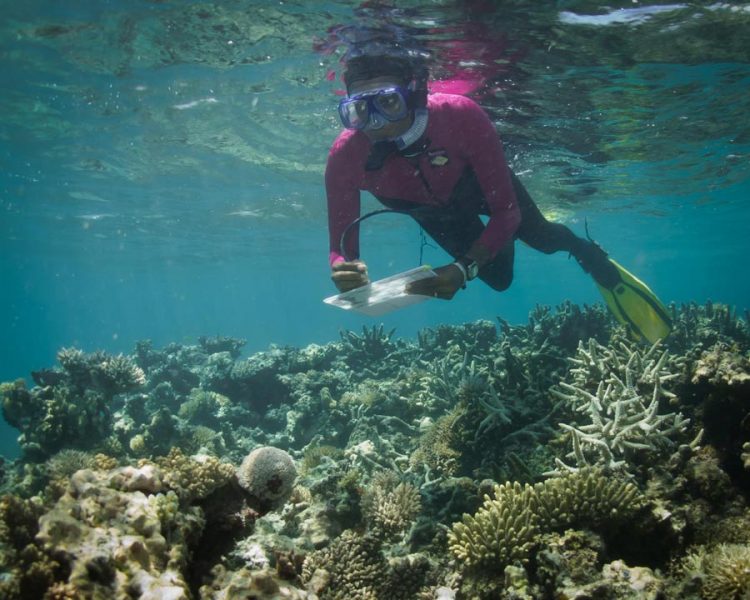New climate stress index model challenges doomsday forecasts for world's coral reefs

A WCS scientist recording data on coral cover in coastal Kenya. A new climate stress model using both environmental data and field observations provides scientists with a more accurate predictive tool than more widely used models based on solely temperature and coral survival thresholds, according to a new study by WCS and other groups. Credit: Emily Darling/WCS
Recent forecasts on the impacts of climate change on the world's coral reefs–especially ones generated from oceanic surface temperature data gathered by satellites–paint a grim picture for the future of the “rainforests of the sea.”
A newer and more complex model incorporating data from both environmental factors and field observations of coral responses to stress provides a better forecasting tool than the more widely used models and a more positive future for coral reefs, according to a new study by the Wildlife Conservation Society and other groups.
The study authors point out that, according to the climate stress index model first developed in 2008, coral reefs are responding to more factors than temperature and therefore more resilient to rising temperatures. They conclude that global climate change is the greatest global threat to coral reefs but the future of these ecosystems is more varied than predictions from the more widely used “temperature threshold” models.
The paper titled “Regional coral responses to climate disturbances and warming is predicted by multivariate stress model and not temperature threshold metrics” appears in the online edition of Climatic Change. The authors are: Timothy R. McClanahan of the Wildlife Conservation Society; Joseph Maina of the Wildlife Conservation Society and the Australia Research Council Centre of Excellence for Environmental Decisions; and Mebrahtu Ateweberhan of the Wildlife Conservation Society and the University of Warwick.
“Our new multivariate stress model suggests that the future of coral reefs is considerably more nuanced and spatially complex than predictions arising from the threshold models,” said Dr. Tim McClanahan, WCS's Senior Conservation scientist and a co-author on the study.
“According to our findings in the Western Indian Ocean, some places will do well and others will not. The key to accurate predictions is using all available environmental data and complementing it with on-the-ground observations on reef cover, coral communities, and other environmental variables that are key to understanding how corals respond to the interaction between all these variables.”
In the study, the authors compared the abilities of three common thermal threshold indices against a stress model that includes temperature but also light and water quality and movement variables and used the models to predict coral cover and susceptibility to bleaching during a past large stress event: specifically the 1997-98 coral bleaching event in the Western Indian Ocean.
The field information used in the test included a compilation of 10 years of coral community data before the bleaching event, two years after the bleaching event, and data during the period of coral recovery between 2001-2005.
While the three temperature threshold models (sea surface temperature, cumulative thermal stress, and annual thermal stress) were highly variable with little agreement to field data after the 1998 rise in temperature and coral mortality, the multivariate model based on 11environmental variables combined using a fuzzy logic systems revealed a more accurate fit with the recorded coral cover and susceptibility in the recovery period that followed.
“This latest research suggests a more optimistic future for the world's coral reefs,” said Dr. Caleb McClennen, Executive Director of WCS's Marine Program. “The ability of certain coral communities to resist and recover from climatic factors provides hope for the future of the oceans. Our imperative is now to seek out and protect those locations that are refuges from climate change, and reduce other human stresses such as fisheries to ensure the long term survival of coral reefs.”
###
This research was supported by the John D. and Catherine T. MacArthur Foundation, the Western Indian Ocean Marine Science Association, and the World Bank Targeted Research Group on Coral Bleaching.
To access the article, go to: http://link.
Media Contact
All latest news from the category: Life Sciences and Chemistry
Articles and reports from the Life Sciences and chemistry area deal with applied and basic research into modern biology, chemistry and human medicine.
Valuable information can be found on a range of life sciences fields including bacteriology, biochemistry, bionics, bioinformatics, biophysics, biotechnology, genetics, geobotany, human biology, marine biology, microbiology, molecular biology, cellular biology, zoology, bioinorganic chemistry, microchemistry and environmental chemistry.
Newest articles

Properties of new materials for microchips
… can now be measured well. Reseachers of Delft University of Technology demonstrated measuring performance properties of ultrathin silicon membranes. Making ever smaller and more powerful chips requires new ultrathin…

Floating solar’s potential
… to support sustainable development by addressing climate, water, and energy goals holistically. A new study published this week in Nature Energy raises the potential for floating solar photovoltaics (FPV)…

Skyrmions move at record speeds
… a step towards the computing of the future. An international research team led by scientists from the CNRS1 has discovered that the magnetic nanobubbles2 known as skyrmions can be…





















